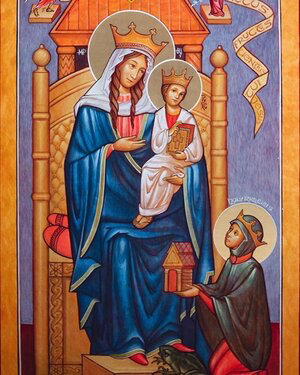Text from The Saint Andrew Daily Missal,
unless otherwise stated.
The Chair of Saint Peter at Antioch.
Feast Day 22 February.
Greater-Double.
White Vestments.
English: Saint Peter as Pope — shown with The Pallium
and The Keys to The Kingdom of Heaven
Magyar: Szent Péter, portréfestménye a szentről, mint pápáról –
a festményen pápai köntösben a mennyország kulcsaival látható.
Français: Saint Pierre. Elle représente le saint en tant que Pape -
vu ici avec le pallium et les clés du Paradis.
Artist: Peter Paul Rubens (1577–1640).
Date: 1610-1612.
Current location: Prado, Madrid, Spain.
Source/Photographer: Originally from en.wikipedia
description page is (was) HERE.
(Wikimedia Commons)
"Tu Es Petrus" [Thou Art Peter].
By Robert Pearsall (1795 - 1856).
Sung on The Feast Day of The Chair of Saint Peter at Antioch.
At The Church of Saint Peter, Steubenville, Ohio, United States of America.
Sung by Schola Cantorum Sanctorum Angelorum
and Students from The Franciscan University.
Conductor: Andrew Leung.
Available on YouTube at
"Asperges Me".
on The Feast Day of The Chair of Saint Peter at Antioch.
At The Church of Saint Peter, Steubenville, Ohio, United States of America.
Sung by Schola Cantorum Sanctorum Angelorum
and Students from The Franciscan University.
Conductor: Andrew Leung.
Cantor: John Brodeur.
Available on YouTube at
To honour the dignity of "The Prince" (Introit), to whom Jesus committed The Power of The Keys (Collect), The Church instituted The Feast of "The Chair of Saint Peter", which is found in The Roman Calendar on this date since 354 A.D.
[The Cathedra (Chair) is The Throne established where the Bishop resides, hence the name Cathedral, given to the Church where the Bishop's Seat is placed. Metaphorically, it represents the Episcopal authority itself. "The Chair of Saint Peter" means, therefore, a memory of Saint Peter's Episcopate, and his Primacy as Head of The Whole Church.]
As it often falls in Lent, certain Churches Celebrated it at an earlier date, in January. Hence, the two Feasts of "The Chair of Saint Peter", which The Church distinguished by connecting the more ancient Feast [Rome, until the 16th-Century, only Celebrated this Feast and not the other Feast] on 22 February, with "The Chair at Antioch", and the other Feast, on 18 January, with "The Chair of Rome". Saint Peter resided, indeed for some time, at Antioch about the years 51 A.D. - 52 A.D.
Saint Peter and Saint Paul.
A Commemoration of Saint Paul immediately follows The Collects of The Feast, today, for The Liturgy does not separate those who have so justly been called "The Two Pillars of The Church".
Artist: René de Cramer.
“Copyright Brunelmar/Ghent/Belgium”.
Used with Permission.
Illustration UNA VOCE OF ORANGE COUNTY
It is to Saint Peter, who proclaimed that Jesus was "The Christ, Son of The Living God" (Gospel), when all Palestine rejected Him, that The Master commits The Power to Bind Satan by Closing The Gates of Hell, to Open for us The Gates of Heaven (Gospel). And The Head of The Church teaches us in his first Epistle that it is "by Faith, in the sprinkling of The Blood of Jesus Christ, that The Holy Ghost Sanctifies us and reconciles us to The Father."
The Commemoration of Saint Paul immediately follows The Collect of The Feast, for The Liturgy does not separate those who have so justly been called "The Two Pillars of The Church".
Let us today honour The Head of The Church, who continues here below the redeeming work of Jesus.
Mass: Státuit ei Dóminus.
Commemoration: Of Saint Paul.
Commemoration: Of The Feria (with Last Gospel), in Lent.
Creed: Is said.
Preface: Of The Apostles.







































